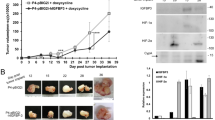Abstract
Hypoxia can promote the progression and metastasis of ovarian cancer, while the underlying mechanisms are still unclear. Hypoxia culture or CoCl2 induced-oxygen deprivation condition could promote SKOV3 cells to express cyclooxygenase-2 (COX2). Luciferase assay indicates that hypoxia-inducible factor 1α (HIF1α) could bind directly with the promoter region of COX2 to promote the transcription. COX2 over-expressed SKOV3 cells show up-regulated stemness-related markers expression, proinflammatory gene expression, and increased tumor sphere formation. The inflammatory molecules (interleukin-6, C-X-C motif chemokine ligand 12, interleukin-1B, interleukin-10, and C-C motif chemokine ligand 2) and COX2 expression show positive correlations in the Cancer Genome Atlas data. COX2 over-expression could promote SKOV3 cell proliferation in the subcutaneous tumor model and metastasis in the transfer model. In conclusion, hypoxia-induced HIF-1α mediated COX2 expression could promote the proliferation, inflammation, and metastasis of ovarian cancer.





Similar content being viewed by others
Data availability
The raw data supporting the conclusions of this article will be made available by the authors, without undue reservation.
References
Agarwal R (2003) The function of COX-2 in human ovarian carcinoma. Am J Pathol 163:368; author reply 368–369–369
Birner P, Schindl M, Obermair A, Breitenecker G, Oberhuber G (2001) Expression of hypoxia-inducible factor 1alpha in epithelial ovarian tumors: its impact on prognosis and on response to chemotherapy. Clin Cancer Res: An Off J Am Assoc Cancer Res 7:1661–1668
D’Ignazio L, Batie M, Rocha S (2017) Hypoxia and inflammation in cancer, focus on HIF and NF-kappaB. Biomedicines 5:21
Deng L, Feng DQ, Ling B (2020) Cyclooxygenase-2 promotes ovarian cancer cell migration and cisplatin resistance via regulating epithelial mesenchymal transition. J Zhejiang Univ Sci B 21:315–326
DiGiacomo JW, Gilkes DM (2018) Tumor hypoxia as an enhancer of inflammation-mediated metastasis: emerging therapeutic strategies. Target Oncol 13:157–173
DiGiacomo JW, Gilkes DM (2019) Therapeutic strategies to block the hypoxic response. Adv Exp Med Biol 1136:141–157
El Khoury L, Furie R (2019) Inflammatory arthritis: a unique presentation of human anaplasmosis. Clin Rheumatol 38:257–259
Flaum N, Crosbie EJ, Edmondson RJ, Smith MJ, Evans DG (2020) Epithelial ovarian cancer risk: a review of the current genetic landscape. Clin Genet 97:54–63
Gartung A, Yang J, Sukhatme VP, Bielenberg DR, Fernandes D, Chang J, Schmidt BA, Hwang SH, Zurakowski D, Huang S, Kieran MW, Hammock BD, Panigrahy D (2019) Suppression of chemotherapy-induced cytokine/lipid mediator surge and ovarian cancer by a dual COX-2/sEH inhibitor. Proc Natl Acad Sci U S A 116:1698–1703
Gasparini G, Longo R, Sarmiento R, Morabito A (2003) Inhibitors of cyclo-oxygenase 2: a new class of anticancer agents? Lancet Oncol 4:605–615
Harris RE (2015) Ibuprofen in the prevention and therapy of cancer. Ibuprofen: Discovery, Development and Therapeutics, John Wiley & Sons, pp 518–546
Horiuchi A, Hayashi T, Kikuchi N, Hayashi A, Fuseya C, Shiozawa T, Konishi I (2012) Hypoxia upregulates ovarian cancer invasiveness via the binding of HIF-1α to a hypoxia-induced, methylation-free hypoxia response element of S100A4 gene. Int J Cancer 131:1755–1767
Icard P, Shulman S, Farhat D, Steyaert JM, Alifano M, Lincet H (2018) How the Warburg effect supports aggressiveness and drug resistance of cancer cells? Drug Resist Updates: Rev Commentaries Antimicrob Anticancer Chemother 38:1–11
Kaidi A, Qualtrough D, Williams AC, Paraskeva C (2006) Direct transcriptional up-regulation of cyclooxygenase-2 by hypoxia-inducible factor (HIF)-1 promotes colorectal tumor cell survival and enhances HIF-1 transcriptional activity during hypoxia. Cancer Res 66:6683–6691
Kemilainen H, Huhtinen K, Auranen A, Carpen O, Strauss L, Poutanen M (2018) The expression of HSD17B12 is associated with COX-2 expression and is increased in high-grade epithelial ovarian cancer. Oncology 94:233–242
La Vecchia C (2017) Ovarian cancer: epidemiology and risk factors. Eur J Cancer Prev: The Off J Eur Cancer Prev Organ (ECP) 26:55–62
Lee HJ, Han HJ (2020) Role of microtubule-associated factors in HIF1alpha nuclear translocation. Adv Exp Med Biol 1232:271–276
Multhoff G, Vaupel P (2020) Hypoxia compromises anti-cancer immune responses. Adv Exp Med Biol 1232:131–143
Nasi ML, Castiglione M (2002) Cyclooxygenase-2 (COX-2) a new prognostic and predictive factor for ovarian cancer? Are all the criteria fulfilled? Ann Oncol: Off J Eur Soc Med Oncol 13:1169–1171
Pantshwa JM, Kondiah PPD, Choonara YE, Marimuthu T, Pillay V (2020) Nanodrug delivery systems for the treatment of ovarian cancer. Cancers 12:213
Roland IH, Yang WL, Yang DH, Daly MB, Ozols RF, Hamilton TC, Lynch HT, Godwin AK, Xu XX (2003) Loss of surface and cyst epithelial basement membranes and preneoplastic morphologic changes in prophylactic oophorectomies. Cancer 98:2607–2623
Semenza GL (2003) Targeting HIF-1 for cancer therapy. Nat Rev Cancer 3:721–732
Sethi G, Shanmugam MK, Ramachandran L, Kumar AP, Tergaonkar V (2012) Multifaceted link between cancer and inflammation. Biosci Rep 32:1–15
Vaupel P, Multhoff G (2020) Fatal alliance of hypoxia-/HIF-1alpha-driven microenvironmental traits promoting cancer progression. Adv Exp Med Biol 1232:169–176
Wang YP, Wang QY, Li CH, Li XW (2018) COX-2 inhibition by celecoxib in epithelial ovarian cancer attenuates E-cadherin suppression through reduced snail nuclear translocation. Chem Biol Interact 292:24–29
Wendel JRH, Wang X, Hawkins SM (2018) The endometriotic tumor microenvironment in ovarian cancer. Cancers 10:261
Yeh YH, Hsiao HF, Yeh YC, Chen TW, Li TK (2018) Inflammatory interferon activates HIF-1a-mediated epithelial-to-mesenchymal transition via PI3K/AKT/mTOR pathway. J Exp Clin Cancer Res 37:70
Zhang T, Suo C, Zheng C, Zhang H (2019) Hypoxia and metabolism in metastasis. Adv Exp Med Biol 1136:87–95
Author information
Authors and Affiliations
Corresponding author
Ethics declarations
Ethical approval
All animal studies were approved by the Ethical Commitment of ZIBO Central Hospital.
Informed consent
Not applicable.
Conflict of interest
The authors declare that they have no competing interests.
Additional information
Publisher’s note
Springer Nature remains neutral with regard to jurisdictional claims in published maps and institutional affiliations.
Rights and permissions
About this article
Cite this article
Ding, Y., Zhuang, S., Li, Y. et al. Hypoxia-induced HIF1α dependent COX2 promotes ovarian cancer progress. J Bioenerg Biomembr 53, 441–448 (2021). https://doi.org/10.1007/s10863-021-09900-9
Received:
Accepted:
Published:
Issue Date:
DOI: https://doi.org/10.1007/s10863-021-09900-9




